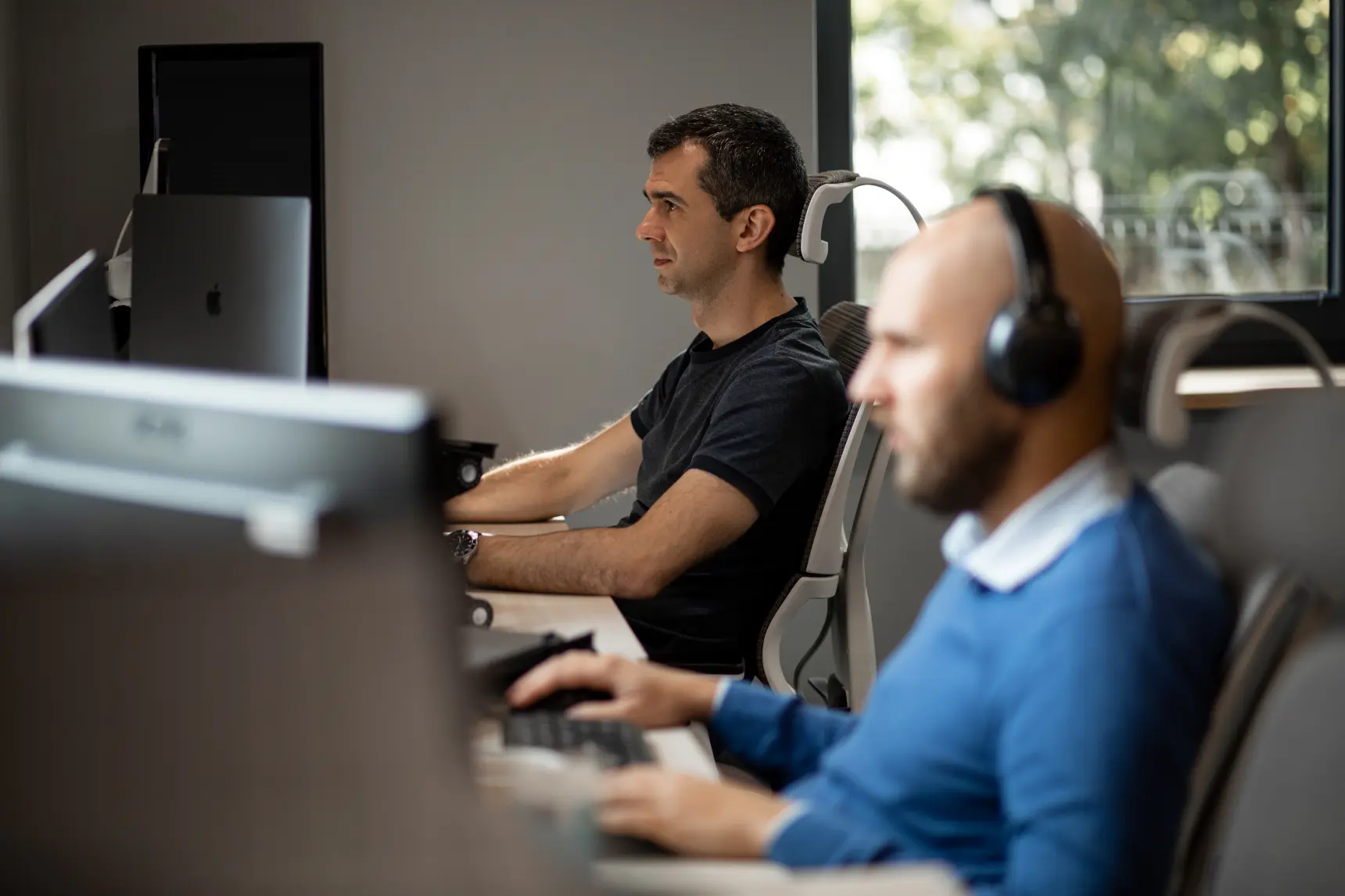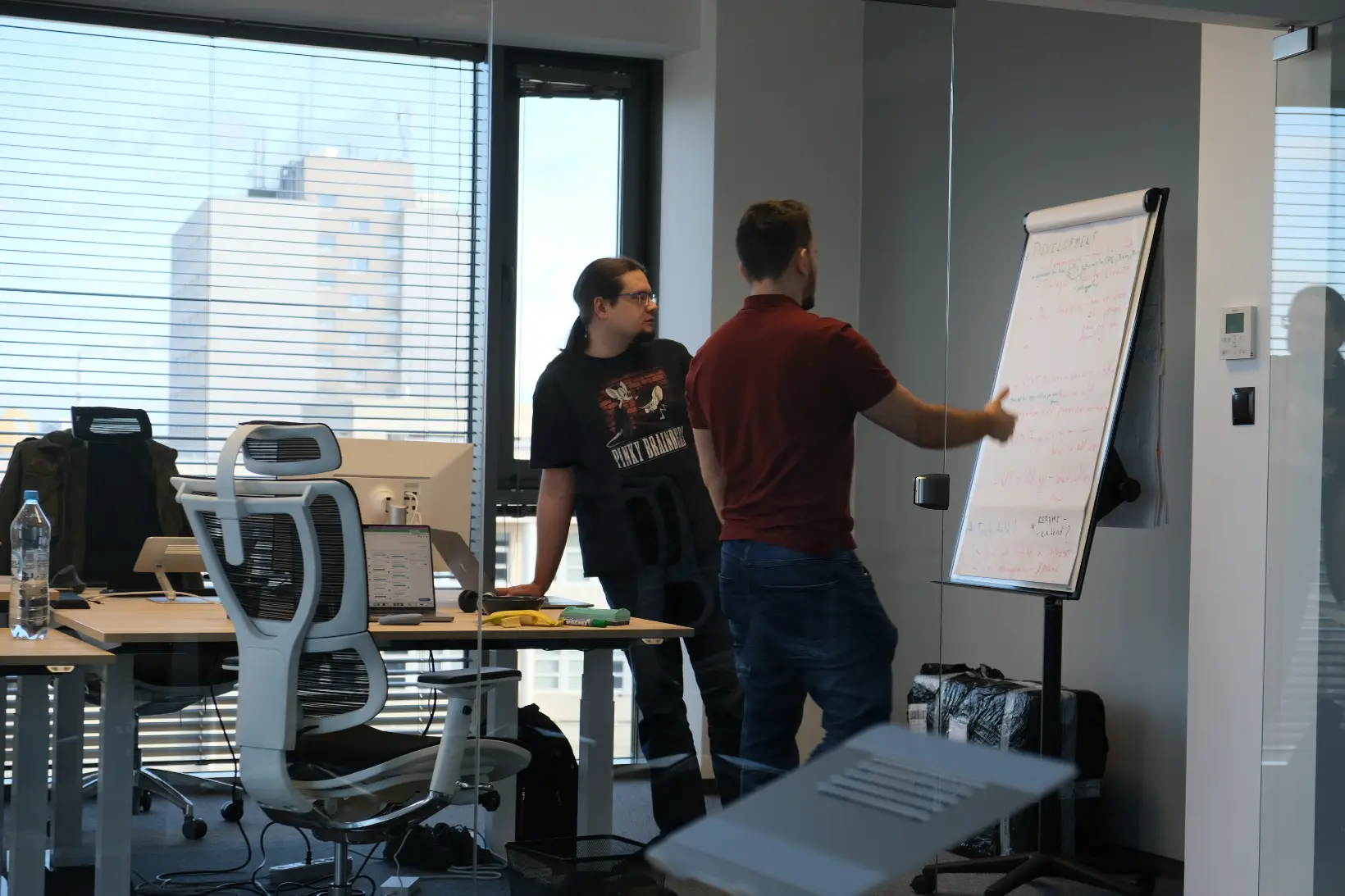Enterprise-level Java engineer. How to grow at Dynamic Solutions

For a developer, it's important to find a job that not only pays the bills, but also is a space to learn and grow. Work should be a rewarding and intellectually stimulating experience - and as a software engineering company, we are committed to build an environment that provides just that.
At Dynamic Solutions, Java engineers have the opportunity to specialize in either Adobe Experience Manager or our proprietary technology called WebSight, with various career pathways available for each.This article provides an insider’s look into enterprise-level technology and the diverse paths that Java developers can take to advance their career.
Enterprise projects and career progression
Dynamic Solutions has been delivering exceptional enterprise web technologies for over a decade now. Our team is primarily composed of senior-level professionals, who are highly skilled in their respective fields.
Although most of our team members specialize in Java, we also cultivate our expertise in front-end development. There’s also a small group of specialists in roles like analysts, UX designers and project managers. Our clients are mostly large companies, coming from diverse industries including airlines, banks, automotive and FMCG. With a combined experience of 100 years in enterprise-level web technologies (we counted!), we take real pride in our team's technical capabilities.
At DS, innovation is a top priority. In the last 2 years, we’ve been developing our own proprietary solution called WebSight. WebSight a real-time Digital Experience Platform, striving to change the web content distribution landscape. We have designed it to make companies' digital presence fast, secure, and scalable. WebSight has been built by engineers for engineers, and is based on Apache Sling, Jackrabbit Oak, and Felix, sharing a core technology stack with mature DXPs like AEM or Magnolia.
The difference between developing enterprise web solutions and a typical Java software project
If you are considering joining our company, or generally picking a career in large-scale projects, here are some observations we have made along the way. If you are transitioning from a typical software development environment, here's what you can expect entering the enterprise-level path:
Your work will start to have an impact on large processes and brands
Compared to regular software projects, enterprise solutions have a broader scope and are designed to cater to the needs of an entire organization, instead of a single department or team. As a result, they typically involve more intricate workflows and business processes, since they need to integrate and coordinate various departments and functions across the large, international company.
This requires a great deal of planning, coordination, and communication. Ultimately, the goal of an enterprise solution is to provide a unified platform for the entire organization, streamlining processes and improving efficiency.
There will be more things to consider when making design decisions
Comprehensive approach is a must when it comes to designing solutions for large organizations. They tend to have diverse and complex requirements that need many software integrations to ensure seamless operations. Security is also crucial, particularly when handling sensitive data.
Enterprise solutions need to be designed to handle a large volume of data and users, so scalability is another factor to take into account. Because of all this, it is vital to carefully evaluate all aspects of design when developing enterprise-level solutions. You need to make sure they are efficient and meet the customers’ needs.
There will be many people involved in each project
Large enterprise projects always involve many people: development teams, stakeholders, and end-users, who need to collaborate at every stage. These teams are often globally dispersed, and this sometimes makes communication and coordination challenging. Managing the expectations of stakeholders can be difficult, as their requirements may not always align. Clear communication is a must - among all parties involved. Developers working on enterprise solutions need to be willing to stay flexible in every scenario.
You’ll stop thinking about “old code” in a way you used to
Solutions built to incorporate the legacy code tend to be extremely efficient and sophisticated - out of sheer necessity. There’s less room for error, compared to working with technologies that are easily replaced. Opting for the enterprise solution path can help you unleash your programming potential and achieve true mastery.
Enterprise projects certainly can be demanding. But mostly, they offer opportunities to build a unique developer’s perspective, leading to innovative and successful outcomes. We strongly believe that working exclusively at the enterprise level has made us all better software engineers.
The benefits of working with enterprise web technologies
Working with enterprise web technologies presents many challenges, as no two tasks are the same here. However, this constant exposure to challenges and problem-solving helps you develop a more holistic approach, focusing on the efficiency and functionality of your program beyond just functions, methods, and classes.
Working with enterprise web technologies also offers the chance to collaborate with some of the industry's best developers, each with their own unique skill set and expertise, promoting continuous learning and growth.Enterprise-level projects are also financially rewarding, providing excellent opportunities for career growth and stability. They contribute to the development of technical and collaboration skills, which are essential for personal and professional growth.
Entering the enterprise world
Dynamic Solutions is a place where you get to constantly level up your skills. Working at DS provides an insight into how to navigate the world of enterprise-level solutions, which - as we already mentioned - requires a certain level of flexibility. Currently, our enterprise level portfolio is split between projects focused on Adobe Experience Manager and ones contributing to our own web-scale solution, the WebSight DXP.
For backend developers, both tracks require a good understanding of Java - but the learning process for each will be slightly different. Adobe Experience Manager provides an opportunity to develop and execute digital experience solutions for prominent clients across sectors such as airlines, banks, automotive, FMCG, and large systems. Conversely, working on WebSight enables developers to innovate with a proprietary solution.
From Java Developer to AEM Developer
Adobe Experience Manager (AEM) is a content management system used by large enterprises for digital content creation, management, and delivery. It enables collaboration between content creators, marketers, and IT teams. To be a successful AEM backend developer, you need a good understanding of Java, as well as other technologies like JCR (Apache Jackrabbit Oak), OSGi (Apache Felix), and Apache Sling.
Dynamic Solutions is often the first place where Java developers are introduced to Adobe Experience Manager. That’s why we offer many resources to help our team members excel in this technology. Learning activities include knowledge-sharing events, workshops and 1:1 sessions of hands-on learning. You’ll have access to courses specifically available to Adobe partners and complete a practice project before you get to work with clients.
From Java Developer to Product Developer
WebSight is a cloud-native DXP that accelerates web pages, ensures security, and simplifies scalability. It is our own, proprietary technology, so working on it offers a unique learning opportunity. Training is led by R&D activities, meaning that you build upon your knowledge as new product needs emerge.
Our R&D department shares their knowledge with the whole company. In addition to regular coding tasks, they also work on our solutions’ architecture and functionalities as a whole. WebSights more than a CMS – it is a Digital Experience Platform for managing both content creation and faster distribution.
Product Development is a path accessible for every developer specialisation within DS. It also presents its own unique challenges, both when it comes to technical skills, as in communication and mindset.
Growing as an enterprise-level developer in Dynamic Solutions
Here's a peek of what you could achieve once you position yourself on a path of enterprise-level development.
Path #1 - Enterprise projects
Once you have mastered AEM, you get to work with clients on large scale projects. As we have outlined before, working with enterprise level projects provides various challenges, but can help you develop a holistic approach to problem-solving, with a focus on program functionality and efficiency. It also offers an opportunity to collaborate with skilled professionals worldwide, allowing for continuous learning, enhancing technical skills, problem-solving abilities, and teamwork.
Learn more in an article: AEM as a Java career. What you need to know - and what you learn along the way
Path #2 - Becoming an architect
As you gain experience, you will be invited to join various organisations and teams as a Dynamic Solutions "special forces" architect. Your tasks will mainly be to identify underlying problems and help the teams to solve them. You will need a broad knowledge base for this role, but also the ability to quickly learn to communicate with the team you join, to support them and be their mentor.
Path #3 - Product Development
This pathway is open to both AEM-trained and WebSight-trained developers of every specialization. In this line of work you get to co-create a product, build domain knowledge, technical expertise, and excellent problem-solving skills. This role not only builds a strong engineering profile, but also the broader ability to think about solutions from the perspective of meeting business needs. People in this role often come up with their own solutions, attend conferences, and write entries for WebSight’s technical blog.
Learn more in an article: Software developer vs product developer. How to (and why) make a shift?
Path #4 - Full Stack Development
On this path you get to create more advanced and intricate digital experiences, since you now fully understand what happens between servers, browsers and apps. This comprehensive understanding of the interactions between servers, browsers, and applications enables you to develop solutions that are optimized for performance, security, and user experience. By leveraging your knowledge of how each component of the digital ecosystem interacts with each other, you can build sophisticated applications that are efficient, user-friendly, and visually stunning.
Conclusion
When working with enterprise level web technologies, you will have many opportunities for growth. The work scope is broader, with more complex workflows and business processes designed to meet the needs of an entire organization. Designing enterprise-level solutions requires careful consideration of many aspects and can be challenging, but it also presents the opportunity for working with some of the best developers in the world, continuous learning, growth, financial stability, and career development.
If you are a Java developer, there are two options for you to work with Dynamic Solutions. You can either become an AEM backend developer, or work towards the development of WebSight, our proprietary Digital Experience Platform. Regardless of which one you choose, you will have the chance to learn and gain valuable experience.


